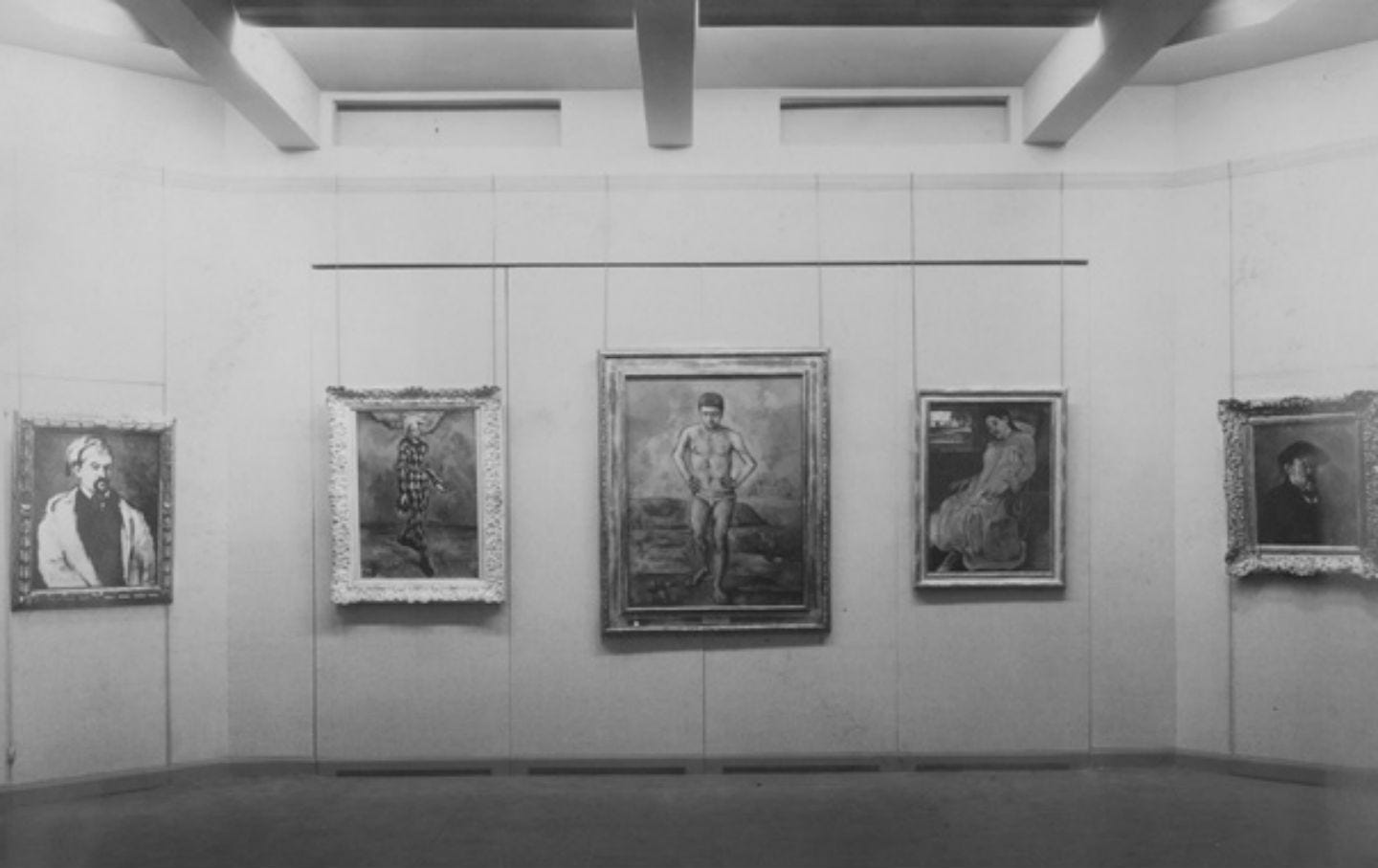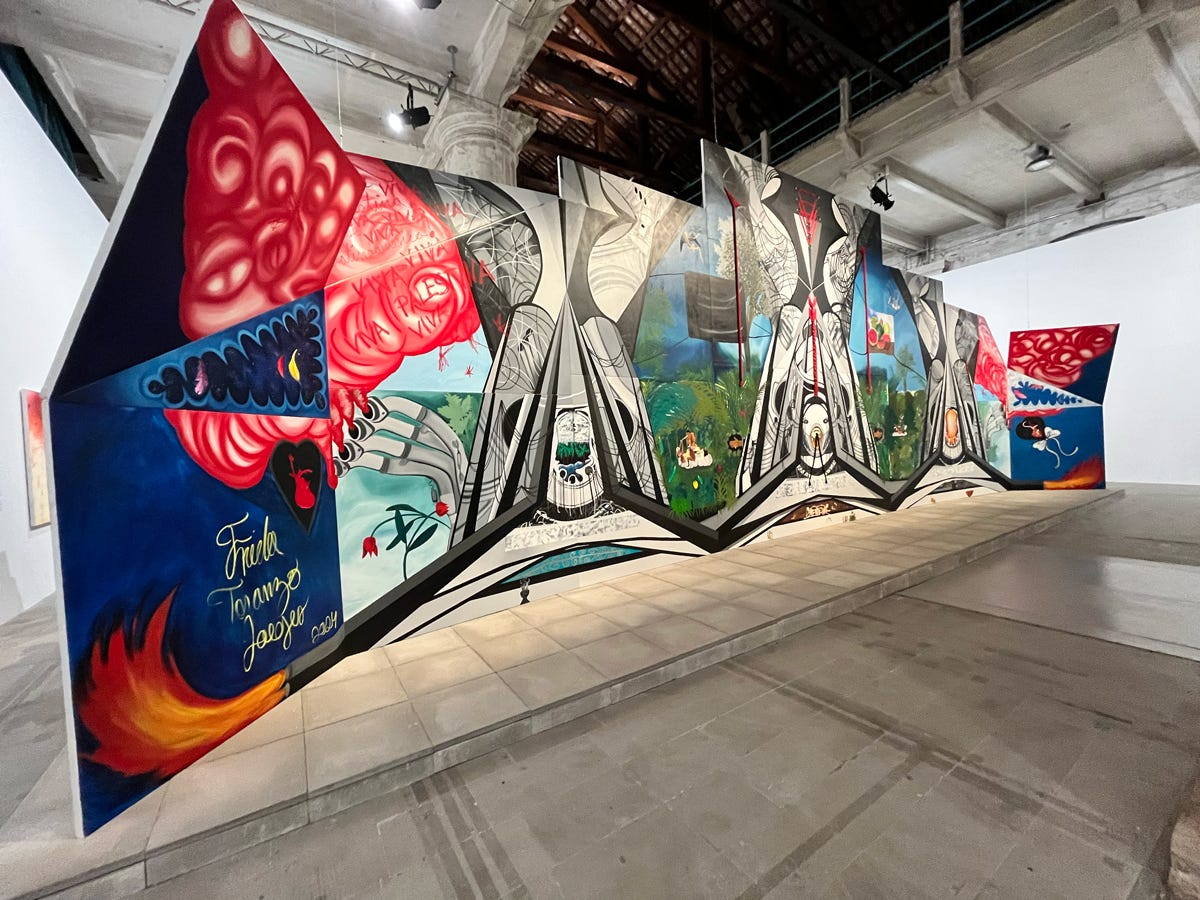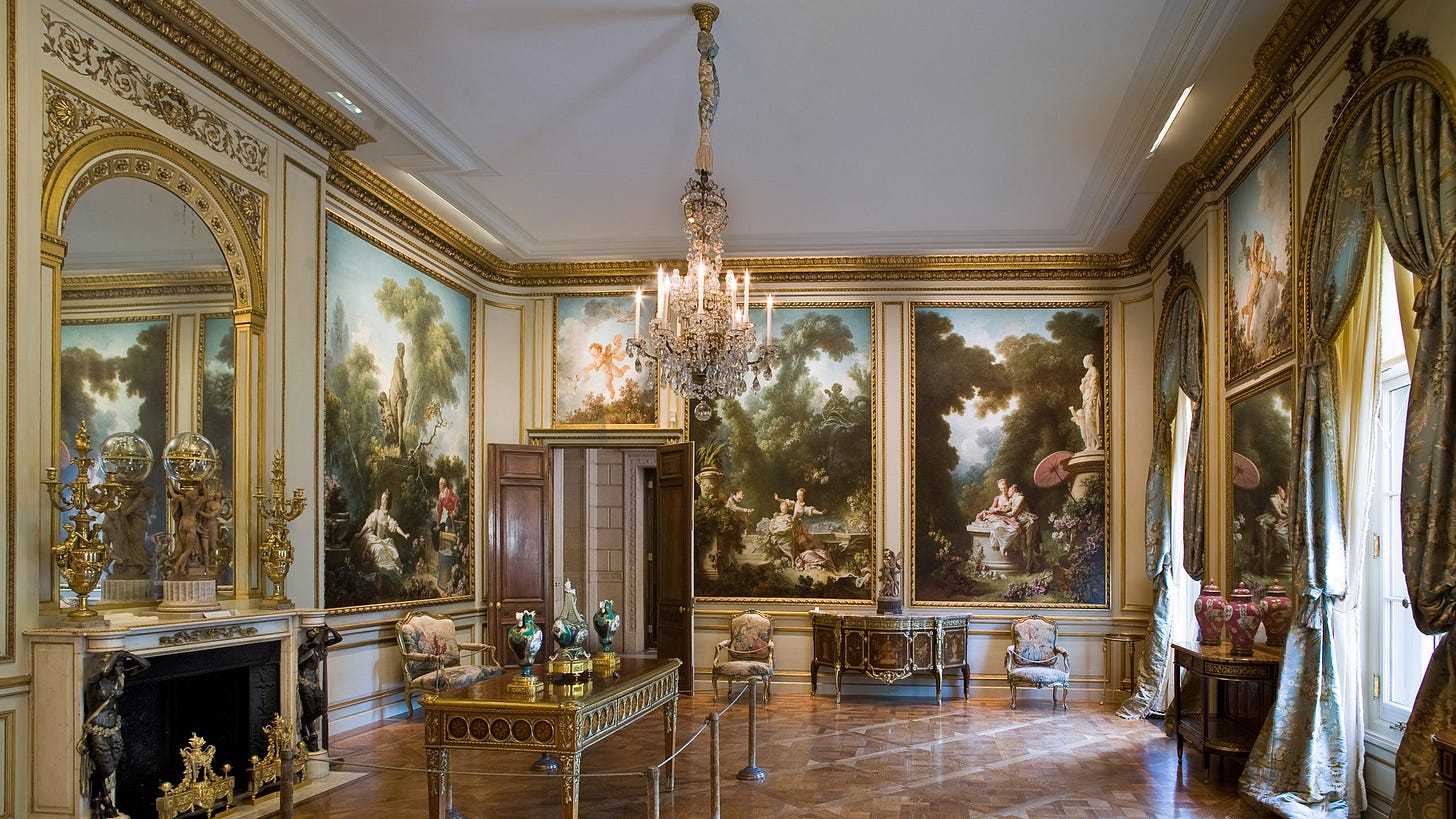How much should you pay for a good story about art?
How much value should we assign to the stories we tell about works of art? Why does that make them more valuable?
Good evening, friends.
The sun beats down on us like we’re shriveling raisins. Did you know New York is officially classified as a humid subtropical climate? Long gone are the snow scenes by Childe Hassam I once romanticized during my American Art days. Funny, isn’t it—watching art do one of its quieter jobs: memorializing what can no longer be recreated. Moments that have already slipped out of reach.
As promised, today we turn to the second pillar of my Art Factor Pricing Model. Last week, we dealt with the tangibles (size, medium, condition), the stuff you can measure with a tape or squint at under a blacklight. But this week, we step into murkier territory: narrative. The myth. The magic. The social proof.
Because once you’ve accounted for what a work is, the real question becomes: Where has it been? And what has it meant?
Paintings don’t just hang on walls. The power of art is magnified in the stories it tells.
Welcome to the Historical Narrative Factors. These are the intangibles that elevate a canvas from object to icon. They’re what let a seller spin a story so compelling, you stop thinking about price—and start thinking about legacy.
So let’s begin.
The three categories we’ll explore:
Provenance
Exhibition History & Literature
Recognizability
Unlike last week’s objective criteria, this is where things get squishy. So I’ll do my best to define each—and round out the nuances with a case study. Enter: The Portrait of Adele Bloch-Bauer I by Gustav Klimt.
A Social History of the Woman in Gold

Quick detour. It’s 2017. I’m a senior in college. My math major is done (pure math, thank you—Wellesley didn’t have a stats department yet, and I wasn’t after their banking jobs, but many assumed if I was in an Economic Statistics class I was gunning for their future Fed chairmanships… so I steered clear). I’d layered in a second major in art history, but I couldn’t leave well enough alone. So I created a year-long independent study.
My topic? Restitution cases. Sparked by the story of the Woman in Gold, the Klimt masterpiece housed at the Neue Galerie in New York—a painting that reshaped how we talk about provenance. What underpinned this research is exactly what underpins my fascination with art and art markets – how do we as humans construct and quantify value around priceless cultural objects?
For those unfamiliar: The Woman in Gold depicts Adele Bloch-Bauer, a prominent Jewish-Austrian socialite rendered resplendent in Klimt’s golden phase. The painting was stolen by the Nazis, eventually ending up in Austria’s national collection. Adele’s niece, Maria Altmann, managed to flee to Los Angeles surviving the Nazi regime that killed the rest of her extended family. Years later, she took the Austrian government all the way to the U.S. Supreme Court suing for the right to have her aunt's portrait restored to her as the descendent of the last legal owner—and won. The painting was restituted to her and subsequently sold to Ronald Lauder for $135 million in 2006, a record at the time.
That sale didn’t just reshape Klimt’s market. It rewrote his narrative.
And what was Georgia in 2017 doing with all this? Trying to calculate how much of that $135 million price tag was derived from the story. What premium did we assign to moral clarity, historical significance, and the chance to own—not just an artwork—but a piece of the human story?
Provenance
A work’s ownership history: part pedigree, part paper trail.
“Provenance” sounds like something you’d use to describe a Burgundy—and you wouldn’t be wrong. In both wine and art, origin matters. Who touched it, who stored it, who fought over it in a divorce.
Provenance tells us who owned the work and when. You can have good provenance, bad provenance—but the real red flag is no provenance. It’s also one of the most powerful tools we have to combat forgery. If you can trace a work from the artist’s hands through reputable collections, you’re in far better shape for your asset to retain its value as the probability of unpleasant histories popping up in later years is lower.
Today, provenance is both incredibly sexy and deeply bureaucratic. Before 1970, almost no one cared where a work came from. Now it can make—or break—a sale. Moral and legal provenance have become battlegrounds for institutional memory, restitution claims, and cultural diplomacy.
Let’s break this down:
Moral Provenance: This is context-dependent, but the question is simple: Was this work somewhere it shouldn’t have been?
You’re looking for signs of forced sales, looting, or exploitative removal—especially during eras we now view through a more ethical lens.For European art: Where was it between 1939 and 1945? (Translation: Was it displaced during the Nazi era? And how?)
For African or Indigenous works: How did it leave its original context? Colonial exhibition? Grave robbing? Any number of exploitative mechanisms imposed on occupied peoples.
For antiquities: Was it trafficked? Does it have proper export permits?
This isn't just about optics. It's about rightful ownership
and the cultural weight of historical memory.
Legal Provenance: OK this is much less romantic and righteous, but also super important. Post-1970, many countries enacted cultural patrimony laws to protect national heritage. If you’re thinking this only works for Etruscan antiquities you’d be wrong, this applies to modern works too. If you’re buying abroad, make sure it’s legal to export. Auction houses offer guidance here. Another reason, frankly, to work with reputable sellers.
Social Provenance: Here’s where it becomes fun. A well-documented provenance gives buyers confidence. It builds trust, helps avoid restitution claims, and creates narrative momentum. If a work was once owned by Gianni Versace or a minor Medici, you can bet it’ll make the catalogue. Prestige travels. And in today’s market, name-dropping a previous owner functions like social proof with a price tag.
Art collecting is a networked game. “From the collection of X” doesn’t just say taste—it says associated prestige (see Exhibition History and Literature for a deeper dive)
Look for markers: gallery stamps from galleries like Duveen (for Old Masters) or Castelli (for Post-War) on the back of the canvas. Exhibition labels from a reputable museum. Or a provenance chain that includes someone with excellent dinner parties.
Sometimes, the provenance is more interesting than the work itself. And occasionally, it’s the only interesting thing. That’s how weird or middling art ends up selling for astronomical prices. David Bowie’s collection at Sotheby’s in 2016 is a perfect example—some gems, some head-scratchers, all buoyed by the Bowie Effect.
This is also why Single Owner Sales perform so well. The May 2025 season proved it: three single-owner collections, 100% sell-through, all beating estimates. Partly because collectors love buying from “good taste,” partly because there’s an emotional charge to works curated—and kept—by one person over time.
Pro tip: I love it when works come from a dealer’s private collection—they usually save the best for themselves and they’ve seen such a great variety of art you tend to know it's a well-considered buy. Or if it’s from the artist’s estate—same logic, plus sentimentality.
Exhibition History & Literature
Has it been shown? And where? And who has written about it?
Let’s start with the obvious:
Works that have been seen are works that have been validated.

A line like “as exhibited at MoMA” does wonders for a price tag. Even a single inclusion in a major institutional show can elevate an otherwise modest work. It’s marketing, yes—but also an academic co-sign.
Think of exhibition history as the visual résumé of an artwork. Each institution that shows it offers a stamp of approval, and collectors take note. Works that have hung on museum walls or traveled through major exhibitions gain something close to an aura. They’ve entered the bloodstream of public—or at least institutional—memory. A showing at MoMA, the Venice Biennale, or even a respected regional museum bestows legitimacy.

And then there’s literature. If a work has been written about, it exists. That might sound obvious, but it’s a real threshold. Art criticism, academic texts, curatorial essays—all of it builds narrative weight.
Inclusion in a catalogue raisonné (the official record of an artist’s verified works) is like a birth certificate for the blue-chip class. The more scholarly attention a work receives, the more staying power it accrues. Why? Because critical writing grants intellectual capital. It situates the work within a discourse and makes it more than just something pretty on a wall.
For collectors with one foot in connoisseurship and the other in legacy-building, that kind of co-sign is irresistible.
So yes—exhibition history and literature might look like supporting characters in the value story, but they’re often doing the heavy lifting. They build credibility. They affirm quality. They help transform the aesthetic into the historical, the private into the public.
And they give collectors something to say when people come over.
Which, let’s be honest, is half the point.
Recognizability
The final thread in the historical narrative braid comes in the recognizability factor. It hinges on a simple question: what has society decided is worth reproducing?
This can take many forms: catalogue raisonné covers, masterpieces copied by art students, museum gift shop tchotchkes that end up on college dorm walls. Bonus points when a work has been replicated across formats and decades—it signals staying power and cultural saturation.
This, after all, is why Da Vinci’s Mona Lisa is the most famous painting in the world. Not necessarily because it’s the best. But because it’s everywhere. Her face has been plastered onto every conceivable and commodifiable surface. T-shirts, tea towels, Tiktoks. We’ve been conditioned to recognize her, and in recognition, we confer value.
It’s a tale as old as time: the more we see something, the more we like it.
Of course, as we touched on in the last edition, the danger of recognizability is oversaturation. There is always a fear that a market will tire of a style or an artist. But in practice—as with advertising—very few things are actually too visible. And by the time that saturation does start to suppress value, it’s usually much further down the curve than anyone anticipates.
In short: repetition breeds comfort. Comfort breeds desirability. And desirability, as we know, breeds value. Even if it comes wrapped in a tea towel.
Example Time
Let’s briefly talk about the Woman in Gold.
So, what was she really worth?
As we look at the Objective Factors:
Size: Substantial. And for Klimt, scale matters.
Medium: Oil on canvas, the gold standard of fine art mediums—pun intended. But more notably, gilded. Gold, as a material, is culturally valuable across nearly every society, and Klimt’s gilded phase represents one of the most creatively explosive moments in his career.
Age: Prime period. This is Austrian Expressionism at its most refined—and from an era especially coveted by collectors of Impressionist, Modern, and early 20th-century masterworks. She is the apogee of Klimt’s work.
Condition: Remarkable, given the chaos of her mid-century journey. Ironically, the same wartime theft that severed her from her rightful owners also ensured she was well cared for—first by Nazis, then by the Austrian state. After the war, she entered a national museum. And today, at the Neue Galerie you just know that if there’s even a whisper of a scratch, there’s a conservation team in white gloves on standby.
Rarity: Where to even begin. Klimt completed over 200 works in his lifetime, but his so-called “Golden Phase” lasted only about five years—roughly 16% of his career. Within that, only one other work (The Kiss) is as generously gilded or as culturally resonant.
NOW, let's look at these new factors I have introduced to you today:
Provenance: The ownership history here isn’t just important—it’s historic. Adele’s story weaves together Klimt’s personal biography, Jewish cultural legacy, European art history, and postwar restitution politics. The 2006 Supreme Court case and subsequent sale to Ronald Lauder didn’t just return a painting—it rewrote the rules of ownership and sparked global discourse about cultural patrimony. This is provenance as cultural landmark. One-of-one (and yes, notice how that intersects with rarity. Valuation is never a clean formula—it’s interlocking multipliers. The magic is in how they reinforce each other.)
Exhibition History & Literature: Too extensive to list here, but suffice it to say—lengthy. She’s been seen, studied, spotlighted. A fixture of both institutional walls and art historical discourse.
Recognizability: Off the charts. Between her prominence during Klimt’s lifetime, her decades on display in Austria, the international press blitz around the restitution case, and the emotionally manipulative (and very public) campaign by the Austrian museum to guilt Maria Altmann into leaving her behind (those farewell posters…), The Woman in Gold became a symbol. Then came the 2015 film adaptation starring Helen Mirren, which brought the entire saga into living rooms around the world. She’s not just known—she’s beloved. She’s storied. She is the crown jewel of the Neue Galerie. Second only to The Kiss, perhaps. But on some days—honestly—I’d argue she wins.
On paper, perhaps $40 million, based on comparable Klimts at the time. But the story—the restitution, the political stakes, the cultural mourning and redemption—added a multiplier. This wasn’t just a portrait. It was an emblem of justice. A reclamation of stolen history. A savvy political flex by a very well-connected collector.
Narrative, in this case, didn’t just enhance value. It was the value.
Why This Matters
Historical narrative factors are the connective tissue between object and culture. They shape perception. They influence demand. They let collectors imagine they’re not just acquiring a painting, but a chapter in art history.
It’s part status, part scholarship, part theater.
Next week, we’ll descend into even murkier territory: Market Factors. The buzz, the heat, the inexplicable it-factor that causes some artists to become omnipresent while others vanish entirely. We’ll talk about reputation, momentum, media, and the myth of meritocracy. Buckle up.
Until then—don’t believe everything you read in a catalogue. But know that someone, somewhere, is definitely paying a premium for it.
Love you nerds,
—G








